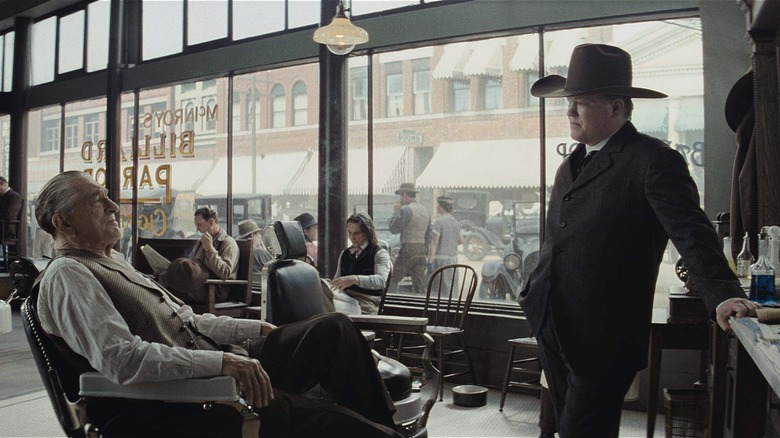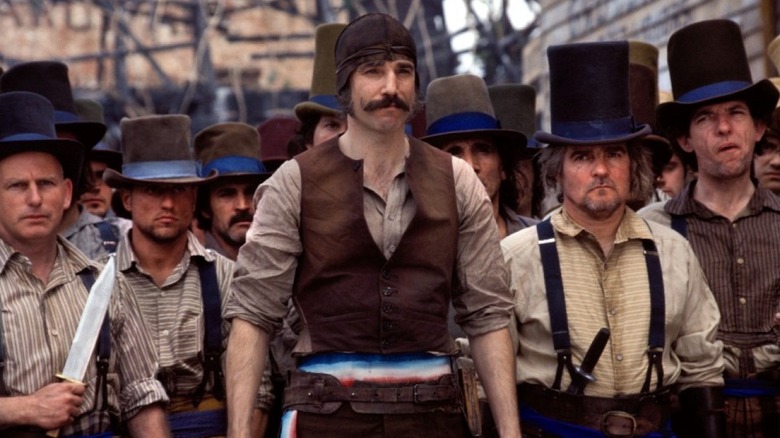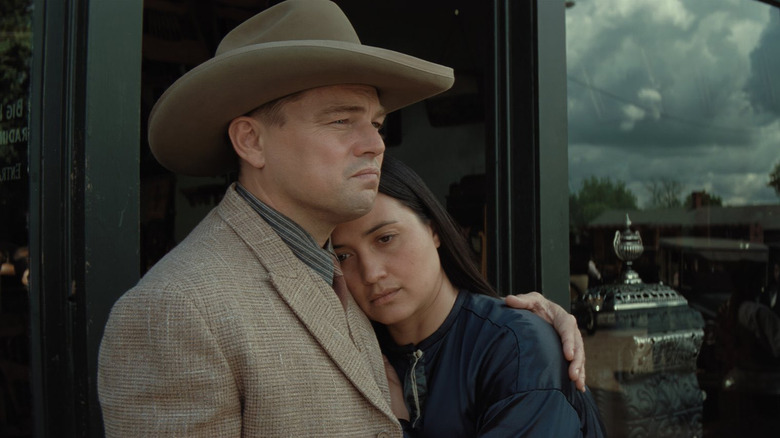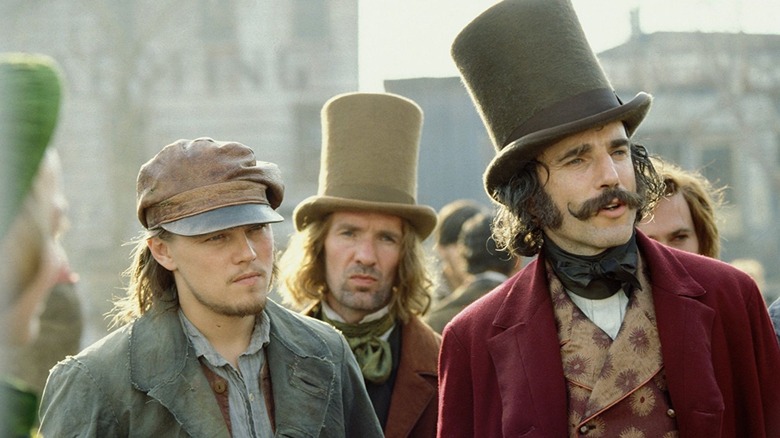Killers Of The Flower Moon Is The Good Version Of Gangs Of New York
Martin Scorsese has long been interested in crime stories. His second feature film, 1972's "Boxcar Bertha," involves a group of bank thieves and freewheeling fugitives. His most recent feature, "Killers of the Flower Moon," made 51 years later, is about the very real organized murders of multiple Osage millionaires at the instruction of William King Hale in Oklahoma in the 1920s. Those who are only passingly familiar with Scorsese's work tend to describe him as a maker of gangster pictures, which isn't accurate. More than anything, when it comes to his crime stories, Scorsese seems interested in ethics-free outliers. He is interested in the kinds of people who have blithely detached from conventional morality, and whose bloody-minded drive toward law-flouting, cruelty, and murder became so widespread they came to color the character of America.
In short, Scorsese is drawn to tales of sociopaths because, as he tells it, sociopaths shaped the nation.
Scorsese, then, often aims to deconstruct American history by finding the dark impulses toward white supremacy and nativism lurking at the nation's heart. With "Flower Moon," Hale sought to siphon money out of the Osage Nation and into the pockets of interloping white men who deliberately infiltrated/married into the Nation at his instruction. 21 years ago, however, Scorsese made "Gangs of New York," a film about violent street toughs in the 1860s — many of them aggressively nativist and anti-immigrant — whose organization into gangs meshed directly into the formation of the city's local politics. A streak of anti-immigrant sentiment, Scorsese argues, was baked into New York from the start.
The difference: "Killers of the Flower Moon" is excellently paced and focused. "Gangs of New York" is a massive, sprawling mess of a film. The former is the better version of the latter.
The land of opportunity
With both "Gangs" and "Flower Moon," Scorsese is deeply cynical about the state of America. In the former, the florid Bill the Butcher (Daniel Day-Lewis) fights to rule New York, in a very literal sense. He takes to the streets with knives and cudgels, hoping to beat to death anyone who would claim territory. He aims to rule over the local businesses, deliberately cheats in elections (he asks men to vote in local elections, then shaves them and has them return to vote again), and is chummy with local politicians and industrialists.
Bill sees America as a land of opportunity, although he sees "opportunity" as a synonym for "exploitation." A new nation, he finds, is ripe for violent control and overseen by a-holes who are unduly fixated on notions of purity. Bill the Butcher wants to keep immigrants out, and make sure that American natives (not Indigenous American, but descendants from the thirteen colonies) are the only ones who are permitted to remain. Scorsese seems to argue that characters like Bill the Butcher had more to do with the founding of the nation than any document-signing "founding fathers."
Likewise with William King Hale. In a revealing scene partway through "Flower Moon," Hale spanks his young charge Ernest (Leonardo DiCaprio) for not sticking to his long-term plan to rob the Osage Nation of its wealth. He admonishes Ernest for forgetting the racist mandate that white men deserve all the money. Hale has presented himself as a hero of the Osage people, speaks their language, and organizes health and community services for them. At the same time, he is murdering its members and asking white men to marry Osage women in an attempt to inherit their oil wealth. A land overlooked by the law is a land ripe for opportunity/exploitation.
Other similarities
So it seems "Gangs" and "Flower Moon" are thematically similar. Both are films about the corrupt heart of America and the soil of exploitation in which the seeds of the nation were planted. Scorsese sees nativism and white supremacy as the central blight of modern American life and is using his historical dramas to explore their origins.
"Gangs" and "Flower Moon" have other more practical similarities as well. They are both, structurally, about a younger, impressionable, not-entirely-innocent "clean slate" character played by Leonard DiCaprio who are both taken under the wings of charismatic, scheming supervillains. Both are about how the world of crime and violence is alluring for this type of character, despite any moral objections they may have (the Leo of "Flower Moon," however, is far more eager to participate than the Leo of "Gangs," who aims to exact a plot of revenge). Both were shot on artificially constructed streets, built specially for the film (although the "Gangs" set was a city unto itself).
So why did "Flower Moon" emerge as so dramatically powerful while "Gangs" came across as unfocused, messy, and chaotic?
A large part may have to do with the pacing. Although both films were edited by Scorsese's longtime collaborator. Thelma Schoonmaker, Scorsese seems to have bitten off more than he could chew with "Gangs." The 2002 film was famously a long-gestating project for Scorsese — he discovered the story in a book way back in the 1970s — and the film feels like it had been in production for 30 years. Every single detail is overblown, every production decision overthought. It doesn't feel epic as it does ungainly. At 167 minutes, it feels like there's way too much of it.
The evils of Harvey Weinstein
"Killers of the Flower Moon," however, was just as massive a production. "Flower Moon" had double the budget of the $100 million "Gangs" and runs 206 minutes, a full 39 minutes longer than "Gangs." Perhaps the extra time allowed Scorsese to pace his film better, let scenes play out, and allow the intimate moments to breathe. "Flower Moon" feels more controlled and deliberate, while "Gangs" feels frantic and bleary. Scorsese may be looking at similar themes and stories, but "Flower Moon" is quite clearly the better-thought-out film. In his 60s, Scorsese was still butting heads with the system. In his 80s, he was clearer about the kind of film he wanted to make.
Infamously, Scorsese hated making "Gangs of New York," which may have a lot to do with the film audiences saw. He and the film's producer, the monstrous Harvey Weinstein, had no end of creative differences, and Scorsese had to face the temperamental Weinstein's caprices on several occasions. The producer also pulled funds at the last minute, and Scorsese had to finish the film with a half million dollars of his own money. It would eventually come out that Scorsese nearly considered retiring altogether because of his bad Weisntein experience. He also admitted that he wasn't happy with his finished film.
It's possible that Scorsese's bad "Gangs" experience galvanized him toward more creative control of his projects moving forward. Seven films later, with "Flower Moon," Scorsese seems to have finally retold the American story he wanted to with "Gangs." It's clear to see that the latter is the smoother, more thoughtful, and overall better movie.



